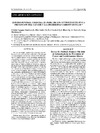Identificador persistente para citar o vincular este elemento:
https://accedacris.ulpgc.es/jspui/handle/10553/73792
| Título: | Estudio SUVIMAX (Francia): el papel de los antioxidantes en la prevención del cáncer y la enfermedad cardiovascular | Otros títulos: | Survey SU.VI.MAX (France): the role of antioxidants in the prevention of cancer and cardiovascular disease | Autores/as: | Martínez, Clotilde Vázquez Galán, Pilar Preziosi, Paul Ribas, L. Serra Majem, Luis Hercberg, Serge |
Clasificación UNESCO: | 320101 Oncología 320613 Vitaminas 32 Ciencias médicas |
Palabras clave: | Antioxidants Cancer Cardiovascular Disease Nutrition Population Involvement, et al. |
Fecha de publicación: | 1998 | Publicación seriada: | Revista Española de Salud Pública | Resumen: | The first ecological epidemiological studies revealed the possible preventive role of some foods which contain antioxidant compounds on cardiovascular disease and on some types of cancer. Nevertheless. later further research and the initial population-based supplementary tests at therapeutic doses have rendered contradictory results. To elucidate the cause-effect relationship of the antioxidant nutrients, the SU.VI.MAX study was considered in France. This is a prospective population-based study of randomized, double blind intervention, the prime objective of which is that of evaluating the effectiveness of a combination of antioxidant minerals and vitamins at nutritional dosages on the morbimortality by cancer and ischemic heart disease of a cohort of 12,749 volunteers of both sexes, ranging from 35 to 60 years of age, spread throughout France over an eight-year period. Likewise, an evaluation was also made of the impact of the supplement on the incidence of infectious disease, cataracts, the individual feeling of well- being and the use of health care resources, the biological markers of the vitamin and mineral status, the antioxidant activity, the immune condition and the evolution of the cardiovascular risk factors. The final points of this study are: the overall mortality, the specific mortality by cancer and/or ischemic heart disease, the incidence of cancer (of any type) and the incidence of ischemic heart disease. The assessment tools employed were: a monthly health questionnaire filled out telematically, a yearly clinical or analytical health check-up every other year, as well as the exhaustive monitoring and documentation of the adverse events and serious health problems. To ascertain the eating behavior and the evolution thereof in the individuals comprising the cohort, an eating survey was filled out twice a month. A description is provided of the means and methods employed in this study, the originality and magnitude of which entail unique aspects which serve to remedy some problems of nutritional epidemiology, as well as the strategies employed for maintaining the active collaboration of the cohort and the exhaustive monitoring thereof. Two years into this study, the consolidation of the monitoring organization and the low drop-out rate afford the possibility of anticipating that the SU.VI.MAX study is going to provide some answers of interest with regard to the relationship between antioxidants and good health. Los primeros estudios epidemiológicos ecológicos pusieron de manifiesto el posible papel preventivo de los alimentos que contienen compuestos antioxidantes, sobre la enfermedad cardiovascular y algunos tipos de cáncer. Sin embargo, ulteriores estudios prospectivos. y los primeros ensayos poblacionales de suplementación a dosis terapéuticas han ofrecido resultados contradictorios. Para dilucidar la relación causa-efecto de los nutrientes antioxidantes se planteó el estudio SU.VI.MAX en Francia. Se trata de un estudio poblacional prospectivo de intervención, randomizado y doble ciego. cuyo objetivo primario es evaluar la efectividad de una combinación de vitaminas y minerales antioxidantes a dosis nutricionales, sobre la morbimortalidad por cáncer y cardiopatía isquémica de una cohorte de 12.749 voluntarios de ambos sexos, de 35 a 60 anos, distribuidos por toda la geografía francesa. a lo largo de 8 anos de seguimiento. Asimismo, se evalúa el impacto del suplemento sobre la incidencia de patología infecciosa. cataratas, el bienestar subjetivo y la utilización de recursos sanitarios. los marcadores biológicos del estatus vitamínico y mineral. la actividad antioxidante, el estado inmunitario y la evolución de los factores de riesgo cardiovascular. Los puntos finales del estudio son: la mortalidad global, la mortalidad específica por cáncer y/o cardiopatía isquémica. la incidencia de cáncer (de cualquier origen) y la incidencia de cardiopatía isquémica. Los instrumentos de valoración empleados son: un cuestionario de salud mensual cumplimentado telemáticamente, un reconocimiento de salud anual, clínico o analítico. en años alternantes, así como la documentación y seguimiento exhaustivo de los acontecimientos adversos e incidencias graves de salud. Para conocer el comportamiento alimentario y 5u evolución en los individuos de la cohorte se cumplimenta una Encuesta alimentaria bimensual .Se describe la metodología del estudio, cuya originalidad y magnitud ofrece peculiaridades que dan respuesta a algunas dificultades de la epidemiología nutricional. así como las estrategias desplegadas para el mantenimiento de la colaboración activa de la cohorte y su seguimiento exhaustivo. A los dos años del comienzo. la consolidación de la estructura de seguimiento, y la baja tasa de abandonos. permiten esperar que el estudio SU.VIMAX aporte respuestas de interés en la relación antioxidantes-salud |
URI: | https://accedacris.ulpgc.es/handle/10553/73792 | ISSN: | 1135-5727 | Fuente: | Revista Española de Salud Pública [ISSN 1135-5727], v. 72 (3), p. 173-183, (Mayo 1998) |
| Colección: | Artículos |
Los elementos en ULPGC accedaCRIS están protegidos por derechos de autor con todos los derechos reservados, a menos que se indique lo contrario.
